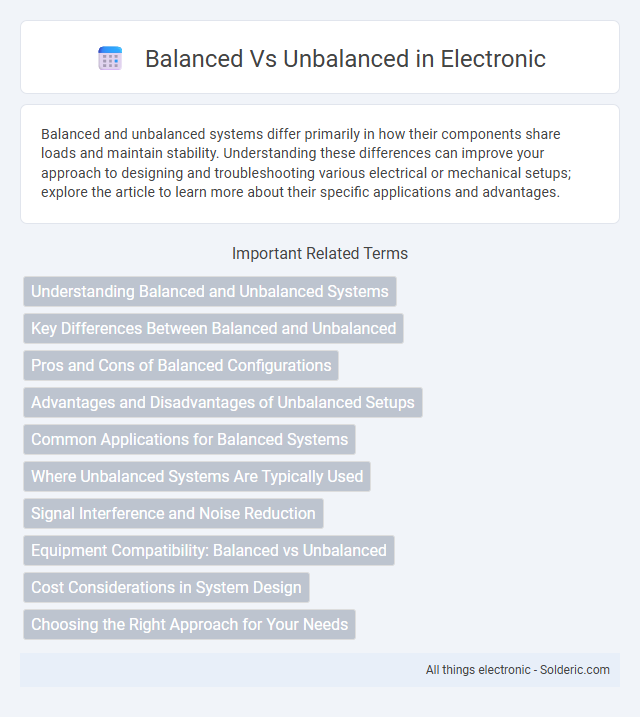Balanced and unbalanced systems differ primarily in how their components share loads and maintain stability. Understanding these differences can improve your approach to designing and troubleshooting various electrical or mechanical setups; explore the article to learn more about their specific applications and advantages.
Comparison Table
| Aspect | Balanced | Unbalanced |
|---|---|---|
| Definition | Equal signal and ground references; symmetrical signal paths | Single signal path with common ground reference |
| Signal Quality | Reduces noise and interference | More susceptible to noise and interference |
| Common Uses | Professional audio, high-quality data transmission | Consumer audio, simple electronics |
| Cable Type | Twisted pair or shielded cables with balanced lines | Coaxial or unshielded cables |
| Cost | Generally higher due to complex wiring | Lower cost, simpler design |
| Connector Types | XLR, TRS (Tip-Ring-Sleeve) | TS (Tip-Sleeve), RCA |
| Distance | Effective over long distances | Best for short distances |
Understanding Balanced and Unbalanced Systems
Balanced systems ensure equal voltage and current distribution across all phases, minimizing interference and improving stability in electrical networks. Unbalanced systems occur when load or impedance varies between phases, leading to voltage fluctuations, increased losses, and potential equipment damage. Accurate analysis and correction of unbalanced conditions are critical for maintaining power quality and system reliability in three-phase electrical engineering.
Key Differences Between Balanced and Unbalanced
Balanced connections use two signal wires with equal impedance and opposite polarity, effectively minimizing electromagnetic interference and noise for clearer audio or data transmission. Unbalanced connections rely on a single signal wire and a ground, making them more susceptible to noise and signal degradation over longer distances. Your choice between balanced and unbalanced affects signal quality, especially in professional audio and long cable runs.
Pros and Cons of Balanced Configurations
Balanced configurations offer superior noise rejection and signal integrity by using differential signaling, making them ideal for professional audio and long cable runs. They are less susceptible to electromagnetic interference and crosstalk, ensuring clearer sound with reduced hum and buzz. However, balanced setups tend to be more complex and expensive, requiring specialized connectors and equipment, which can increase overall system cost and setup time.
Advantages and Disadvantages of Unbalanced Setups
Unbalanced audio setups offer simplicity and lower cost, making them ideal for short-distance connections and consumer electronics. However, they are more prone to signal interference and noise over longer cable runs, leading to potential audio degradation. The lack of noise rejection in unbalanced configurations limits their use in professional and high-fidelity environments where signal integrity is critical.
Common Applications for Balanced Systems
Balanced audio systems are widely used in professional audio environments such as recording studios, live sound reinforcement, and broadcasting due to their superior noise rejection and signal integrity over long cable runs. These systems are ideal for connecting microphones, mixing consoles, and powered speakers where minimizing interference is critical. Common applications also include AV installations in theaters and conference rooms, where maintaining high audio quality and reducing hum or electromagnetic noise is essential.
Where Unbalanced Systems Are Typically Used
Unbalanced systems are typically used in short-distance audio connections such as connecting instruments to amplifiers or consumer audio devices like home stereos and televisions. These systems are favored in environments where electromagnetic interference is minimal, making them ideal for lightweight and cost-effective setups. You will often find unbalanced cables with RCA or 1/4-inch TS connectors in these applications.
Signal Interference and Noise Reduction
Balanced audio cables use two signal conductors with opposite polarities, effectively canceling out electromagnetic interference and reducing noise in audio transmissions. Unbalanced cables rely on a single conductor and a ground wire, making them more susceptible to signal interference, especially over long distances. This inherent design difference results in balanced connections providing superior noise reduction and cleaner audio signals compared to unbalanced setups.
Equipment Compatibility: Balanced vs Unbalanced
Balanced connections utilize three conductors--positive, negative, and ground--to reduce noise and interference, making them compatible with professional audio equipment such as mixers, interfaces, and high-end microphones. Unbalanced connections use two conductors--signal and ground--and are commonly found in consumer devices like guitars and standard headphones, but they are more susceptible to signal degradation over long cable runs. Ensuring your equipment supports balanced connections maximizes audio quality and minimizes interference in complex setups.
Cost Considerations in System Design
Balanced systems often incur higher initial costs due to the need for equal impedance components and superior connectors, enhancing signal integrity and reducing electromagnetic interference. Unbalanced systems typically offer lower costs, using simpler components and connectors, but may require additional shielding or signal conditioning to mitigate noise, potentially increasing long-term expenses. Your choice should weigh upfront budget constraints against future maintenance and performance costs to achieve optimal system design efficiency.
Choosing the Right Approach for Your Needs
Choosing between balanced and unbalanced systems depends on the specific requirements of your audio or data transmission setup, with balanced configurations offering superior noise rejection ideal for long cable runs or high-interference environments. Unbalanced systems provide simpler, cost-effective solutions suitable for short distances with minimal interference. Assess factors like cable length, signal integrity, and environmental noise to determine the optimal approach for your application.
Balanced vs Unbalanced Infographic

 solderic.com
solderic.com